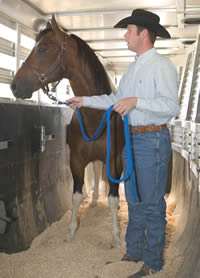Some horses are happy in all but the most bitter temperatures, while others shiver on the first cold night of fall. To figure out if your horse needs a blanket, answer the following yes-or-no questions. A “yes” answer to any one means your horse would appreciate a little extra insulation.

1. Is it below 50 degrees Fahrenheit? Even if your horse has a natural (unclipped) haircoat, he may appreciate a blanket at this temperature. This is just a general rule of thumb, since other factors (such as wind, humidity and/or precipitation) may call for a blanket when it’s warmer. On the other hand, some horses acclimate to colder temperatures, especially those with thick haircoats.
2. Is his coat clipped? If so, your horse may need a blanket (or at least a sheet) when the mercury drops below 60 degrees F.
3. Does he usually live indoors? If your horse lives even part of the time in a warm barn, he’ll feel the cold more than a horse that lives outside full time.
4. Does he live in an open pasture? A full-time outdoor horse will grow a heavy coat to ward off the elements, but wind and rain can destroy that insulating effect. If there’s no shelter in his pasture, he may need wind- and water-resistant horse clothing to stay warm.
5. Is his stall drafty? Drafts in your barn may have the same effect as outside breezes–they blow away that layer of warm air next to your horse’s skin, making him feel colder.
6. Is he shivering? Don’t go by formulas–check your horse to see whether he’s too cold. If he’s shivering, blanket him (or add blankets) and get him to a shelter. (To see if your horse is too warm, slide your hand under his blanket; if he’s sweaty, he needs a lighter covering, or none at all.)
Dr. Hower-Moritz is an associate professor of equine science at University of Minnesota, Crookston.
This article originally appeared in the October 2000 issue of Horse & Rider magazine.






